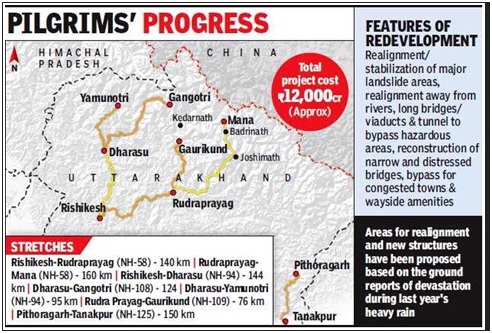

12th February 2022 (6 Topics)
Context
Environmentalist Ravi Chopra has resigned as chairman and member of the High Powered Committee (HPC) for the Char Dham Project.
About
About Chardham Project:
- Objective:CharDham Pariyojana aims to “improve the connectivity to the Chardham pilgrimage centres (Badrinath, Kedarnath, Gangotri, Yamunotri) in the Himalayas, making journeys to these centres safer, faster and more convenient.
- It will widen almost 900 km of highways connecting the pilgrimage sites and the Tanakpur-Pithoragarh stretch of National Highway (NH) 125, a part of the Kailash Mansarovar Yatra route.
- Role in National Security:This project can act as the strategic feeder roads which connect the India-China border with the Army camps in Dehradun and Meerut where missile bases and heavy machinery are located.
- Implementing Agencies:
- Uttarakhand State Public Works Department (PWD)
- Border Roads Organisation (BRO)
- National Highway & Infrastructure Development Corporation Limited (NHIDCL)

How High-Powered Committee (HPC) was constituted?
- The Supreme Court Case: The MoRTH's road-expansion project was in 2018 challenged for its potentially hazardous impact on the Himalayan ecology.
- The Objections: Environmentalist groups in their plea opposed the widening of the highway, cited the massive landslides and other environmental disasters that have resulted due to felling of trees and destruction of ecosystems for infrastructure projects.
- A High-Powered Committee (HPC) was set up the Supreme Court to consider the cumulative and independent impact of the Chardham project on the Himalayan valleys.
The Report of the High-Powered Committee:
- In July 2020, the HPC submitted two reports after members of the panel conflicted on the ideal width for hill roads. The minority recommendation, made by 4 members of the HPC argued that “a disaster-resilient road is much more critical” than a wider road “prone to frequent blockages, landslides and recurring slope failures”.
Supreme Court Rules in Favour of 5.5 KM Road Length:
- The Supreme Court in September 2020 upheld the recommendation of the minority, ruling that the carriageway width should be limited 5.5 m in the precarious terrain.
The Supreme Court's Judgment:
- Pronouncing judgment in the Char Dham case, the Supreme Court in December 2021, allowed the double-lane paved shoulder configuration for the Chardham road project.
- The court's order was devised taking into consideration the recent security challenges at the India-China border, and the strategic importance of having double-lane roads for swift movement of the armed forces.


